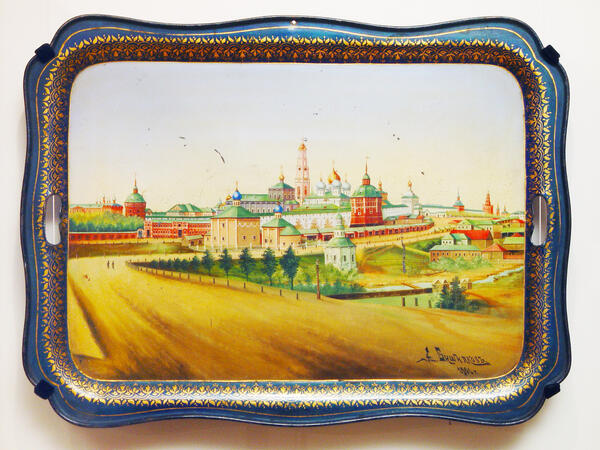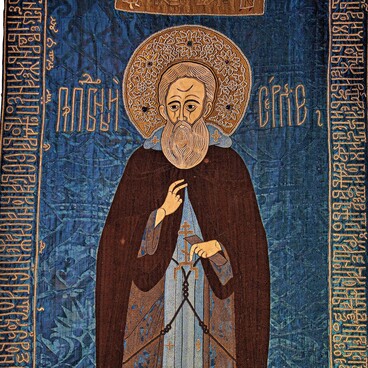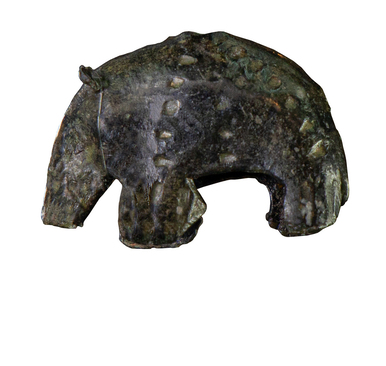The tray with a view of the Trinity Lavra of St. Sergius is one of the rare works of folk art of painting on metal in the village of Zhostovo near Moscow. Its value is is due to the unusual subject matter of the painting, the high level of craftsmanship and the presence of the signature left by the master: “A. Vishnyakov. 1901”. This was a rare instance in the art of Zhostovo at that time.
The author of this work is the artist Alexander Vishnyakov, better known by his monastic name Affonius. He was the last representative of the family of peasant painters and organizers of tray production in the village of Zhostovo.
In 1892, Vishnyakov became a novice and then a monk of the famous monastery. But even during his monastic years, he continued to make trays. The exhibition presents a sample preserved in the Trinity Lavra of St. Sergius. It depicts one of the most beautiful views of the monastery: from the south-eastern side, from the Blinnaya Hill of Sergiev Posad. The appearance of the monastery here is perceived as an image of an ideal world. Its beauty and inner harmony is emphasized by a strip of cloudless sky, worked out with thin glazing — translucent strokes, as well as the regular shapes of trees and figures of the staffage. Staffage is referred to as secondary elements of the composition which enliven the landscape: on the tray, these are figures of people walking along the road. The conventional and static nature of the composition, its bright color suggest the folk character of the painting.
After the revolution, when the Trinity Lavra of St. Sergius was nationalized and closed, Affonius Vishnyakov stayed in Sergiev (from 1930 this town was renamed Zagorsk) for good. Vishnyakov started organizing the production of lacquer goods made of papier-mache and wood: he made boxes, powder-boxes, knives for paper, tumblers for pencils and other items, decorating them with impeccably painted, vibrant still lifes and conventionally rendered landscapes. Today, the collections of the largest museums in the country keep the works of Alexander Vishnyakov of 1920-1930s. The tray with a view of the Trinity Lavra of St. Sergius is the only known early work of the master.
The author of this work is the artist Alexander Vishnyakov, better known by his monastic name Affonius. He was the last representative of the family of peasant painters and organizers of tray production in the village of Zhostovo.
In 1892, Vishnyakov became a novice and then a monk of the famous monastery. But even during his monastic years, he continued to make trays. The exhibition presents a sample preserved in the Trinity Lavra of St. Sergius. It depicts one of the most beautiful views of the monastery: from the south-eastern side, from the Blinnaya Hill of Sergiev Posad. The appearance of the monastery here is perceived as an image of an ideal world. Its beauty and inner harmony is emphasized by a strip of cloudless sky, worked out with thin glazing — translucent strokes, as well as the regular shapes of trees and figures of the staffage. Staffage is referred to as secondary elements of the composition which enliven the landscape: on the tray, these are figures of people walking along the road. The conventional and static nature of the composition, its bright color suggest the folk character of the painting.
After the revolution, when the Trinity Lavra of St. Sergius was nationalized and closed, Affonius Vishnyakov stayed in Sergiev (from 1930 this town was renamed Zagorsk) for good. Vishnyakov started organizing the production of lacquer goods made of papier-mache and wood: he made boxes, powder-boxes, knives for paper, tumblers for pencils and other items, decorating them with impeccably painted, vibrant still lifes and conventionally rendered landscapes. Today, the collections of the largest museums in the country keep the works of Alexander Vishnyakov of 1920-1930s. The tray with a view of the Trinity Lavra of St. Sergius is the only known early work of the master.



